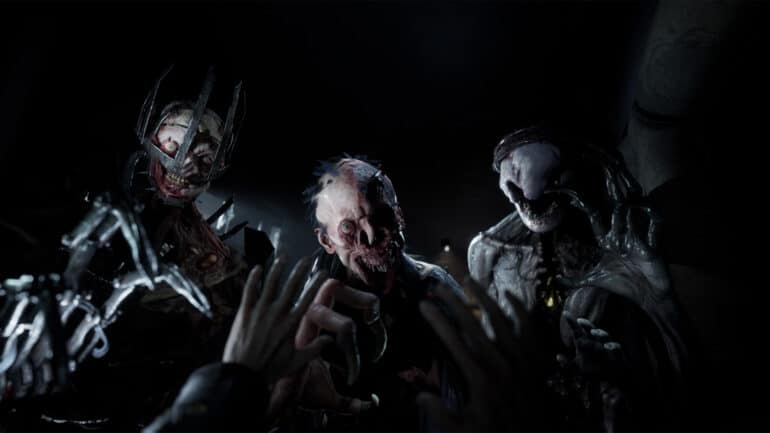There’s an abundance of indie horror games out there, but many of them tend to follow the same clichéd spooky walking simulator formula without offering much that stands out. However, it’s not often you come across horror games that delve into the grim themes of war and violence. Nacon and Hekate’s latest project, Ad Infinitum, thrusts you headfirst into the harrowing trenches of World War I, placing you in the shoes of a young German soldier haunted by the war’s aftermath and the impact it has had on his family.
Ad Infinitum takes its name from the Latin phrase meaning “again and again, in the same way; forever” or “infinity,” and this concept reflects the gameplay itself. So, what exactly will you find yourself doing repeatedly? Well, you’ll likely spend a lot of time grappling with the game’s unclear objectives because it does a rather subpar job of guiding you.
In the game, you step into the shoes of Paul Von Schmitt, who is grappling with psychological torment as he navigates between his family home and the war-ravaged battlefields in search of a lasting remedy for his suffering. Right from the start, you might draw parallels between this game and Amnesia, particularly the recent release, The Bunker, which also unfolds within the backdrop of wartime.

“Ad Infinitum doesn’t strive to innovate within the genre.”
The dual-setting dichotomy does a great job of displaying the differences between the brutality of the trenches and the repercussions it had on families back home. The family residence serves as a central hub, while various levels transport you to battlefield sequences. Although both locations feature scripted jump scares, the home environment exudes a more somber and tranquil ambiance, accompanied by background music, while the trenches manifest as twisted and nightmarish.
Ad Infinitum adopts a first-person perspective and employs most, if not all, elements of a typical psychological horror experience. You can expect to search for clues, read documents, solve puzzles, and evade menacing entities.
However, Ad Infinitum doesn’t strive to innovate within the genre; instead, it adheres to familiar encounters. Despite having a pickaxe and rifle at your disposal, genuine combat or self-defense situations are absent. There are “Boss” encounters that occasionally place you in confined arenas, where you must interact with objects to escape or impede their attacks.
The game generously provides checkpoints, and if you happen to meet an untimely demise, you’ll respawn at a nearby military medic bed, which I thought was a nice added touch. Ultimately, the game doesn’t quite reach the heights of other fear-inducing titles, with its mechanics appearing rather generic and uninspired. Instead, the narrative takes center stage and holds its ground. The story skillfully explores the traumas of war, offering a poignant glimpse into the main character’s relationships with his brother and parents.

“I often found myself grappling with frustrating technical issues.”
For those that aren’t aware, Ad Infinitum was delayed from its initial April release date with the launch pushed back to September for further polishing. One can only wonder about the state of the game at the earlier date, given the abundance of bugs and poor quality-of-life mechanics in the current version.
There was a moment when I was on the verge of giving up on the game after aimlessly navigating a house for a solid 30 minutes without any clear guidance on what to do next. As it turned out, a critical prompt failed to appear due to a bug, forcing me to reboot the game to continue.
Furthermore, certain audio segments are also bugged, resulting in an absence of any dialogue or environmental sound effects. A horror game should be intuitive and accessible enough so that players can focus on the experience, but I often found myself grappling with frustrating technical issues. Additionally, some of Ad Infinitum‘s design choices also raise some eyebrows. The darkness levels are so extreme that, at times, it becomes nearly impossible to see what’s happening, particularly within the confines of the house.

“The current cost of Ad Infinitum is excessively high.”
While I understand the intent to create an eerie atmosphere, excessively low visibility feels like poor design. Players should at least be able to navigate and see where they’re headed. Moreover, many prompts for interactable objects fail to appear unless your cursor is precisely aligned, leading to countless instances where I couldn’t open doors or break wooden barriers due to the absence of prompts.
Lastly, when looking at collected documents, the white text becomes nearly unreadable against the white background of the documents themselves. Also, I noticed that some text documents featured voice-acting, while others didn’t, showing a lack of consistency in this aspect. It’s surprising that these important details were overlooked during the quality assurance and polishing process.
I’ve always been puzzled by the pricing disparities between indie games on consoles and Steam, especially when there don’t seem to be any additional features or advantages offered. Despite being an indie game, Ad Infinitum carries a hefty price tag of US$40 on PlayStation 5, compared to its introductory launch price of US$31.49 on PC. It would have been a much more straightforward recommendation if the game were priced at a more reasonable US$20 or less because the current cost is excessively high. On top of that, there’s also the “Nightmare” edition, which commands an extra US$10 for a digital artbook, soundtrack, and early access to the game.

“One notable highlight is the visual design of the monstrous entities.”
Performance-wise, Ad Infinitum runs reasonably well on PlayStation 5. Load times are neither lightning-fast nor agonizingly slow. Regrettably, the game doesn’t make use of any of the DualSense controller’s features, so don’t expect any haptic feedback or adaptive triggers.
Strangely, the sound tends to be obnoxiously loud, even when the TV volume is set to a minimum, so I’d advise lowering the master audio in-game. Character animations might come across as somewhat rigid, though some leniency can be granted in that regard. Nevertheless, one notable highlight is the visual design of the monstrous entities. These sickening creatures serve as representations of your mental anguish and well-being, and the artists behind the game have done a remarkable job of portraying their creativity.
Ad Infinitum does a commendable job of examining the horrors of World War I through the lens of a young German soldier. The dual backdrop of his old family home along with the trenches of the battlefield allow for an imaginative take on the psychological horror genre. However, the uninspired gameplay systems, lack of overall polish, and hefty price tag prevent the game from standing out in the crowded landscape of indie horror titles.
*Disclaimer: Reviewed on PS5; code was provided by the Publisher.







